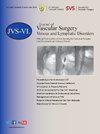Successful treatment of severe venous leg ulcers and diabetic foot ulcers using ozone
IF 2.8
2区 医学
Q2 PERIPHERAL VASCULAR DISEASE
Journal of vascular surgery. Venous and lymphatic disorders
Pub Date : 2025-06-13
DOI:10.1016/j.jvsv.2025.102278
引用次数: 0
Abstract
Background
Venous leg ulcers (VLUs) and diabetic foot ulcers (DFUs) are chronic wounds associated with significant morbidity, high recurrence rates, and poor healing outcomes. Conventional treatments often fail to achieve satisfactory results, leading to prolonged pain, infection risks, and reduced quality of life. Oxygen-ozone therapy (OOT) has emerged as a potential adjunct to conventional wound care, with antimicrobial, anti-inflammatory, and tissue-regenerating properties. This study evaluates the efficacy of OOT in treating severe VLUs and DFUs.
Methods
A total of 25 patients (mean age, 57.2 ± 10.51) with refractory VLUs (n = 18) or DFUs (n = 7) received OOT alongside standard care. Treatment protocols included major autohemotherapy (O2-O3-MAHT), topical ozone application, and localized ozone injections. Clinical assessments included pain scoring (Numeric Rating Scale), microbiological evaluations, and logistic regression analysis to determine healing rates.
Results
At 4 weeks, pain scores decreased by 73.27% (P < .0001), and 92% of septic lesions showed negative bacterial cultures. Logistic regression analysis indicated a significant improvement in healing rates (P < .0001), with 80% of patients achieving complete wound closure. Inflammatory markers were reduced, and tissue regeneration was enhanced.
Conclusions
OOT demonstrated substantial efficacy in reducing infection, alleviating pain, and promoting wound healing in patients with severe VLUs and DFUs, restoring their healthy, normal limbs. These findings support the use of OOT as a valuable adjunctive treatment. Further large-scale, randomized trials are needed to optimize treatment protocols and confirm long-term benefits.
应用臭氧成功治疗严重静脉性腿溃疡(VLUs)和糖尿病足溃疡(DFUs)。
背景:下肢静脉溃疡(VLUs)和糖尿病足溃疡(DFUs)是一种慢性伤口,发病率高,复发率高,愈合效果差。常规治疗往往不能达到令人满意的效果,导致疼痛延长,感染风险,并降低生活质量。氧臭氧疗法(OOT)已成为传统伤口护理的潜在辅助手段,具有抗菌、抗炎和组织再生的特性。本研究评估OOT治疗严重vlu和dfu的疗效。方法:共有25例难治性vlu (n=18)或dfu (n=7)患者(平均年龄57.2±10.51 SD)在标准治疗的同时接受OOT治疗。治疗方案包括主要的自体血液治疗(O2-O3-MAHT),局部臭氧应用和局部臭氧注射。临床评估包括疼痛评分(数值评定量表,NRS)、微生物学评估和逻辑回归分析以确定治愈率。结果:4周时疼痛评分下降73.27% (p < 0.0001), 92%脓毒症灶细菌培养阴性。Logistic回归分析显示,愈合率显著提高(p < 0.0001), 80%的患者伤口完全愈合。炎症标志物减少,组织再生增强。结论:OOT在严重vlu和dfu患者中具有减少感染、减轻疼痛和促进伤口愈合的显著疗效。这些发现支持OOT作为一种有价值的辅助治疗。需要进一步的大规模随机试验来优化治疗方案并确认长期效益。
本文章由计算机程序翻译,如有差异,请以英文原文为准。
求助全文
约1分钟内获得全文
求助全文
来源期刊

Journal of vascular surgery. Venous and lymphatic disorders
SURGERYPERIPHERAL VASCULAR DISEASE&n-PERIPHERAL VASCULAR DISEASE
CiteScore
6.30
自引率
18.80%
发文量
328
审稿时长
71 days
期刊介绍:
Journal of Vascular Surgery: Venous and Lymphatic Disorders is one of a series of specialist journals launched by the Journal of Vascular Surgery. It aims to be the premier international Journal of medical, endovascular and surgical management of venous and lymphatic disorders. It publishes high quality clinical, research, case reports, techniques, and practice manuscripts related to all aspects of venous and lymphatic disorders, including malformations and wound care, with an emphasis on the practicing clinician. The journal seeks to provide novel and timely information to vascular surgeons, interventionalists, phlebologists, wound care specialists, and allied health professionals who treat patients presenting with vascular and lymphatic disorders. As the official publication of The Society for Vascular Surgery and the American Venous Forum, the Journal will publish, after peer review, selected papers presented at the annual meeting of these organizations and affiliated vascular societies, as well as original articles from members and non-members.
 求助内容:
求助内容: 应助结果提醒方式:
应助结果提醒方式:


